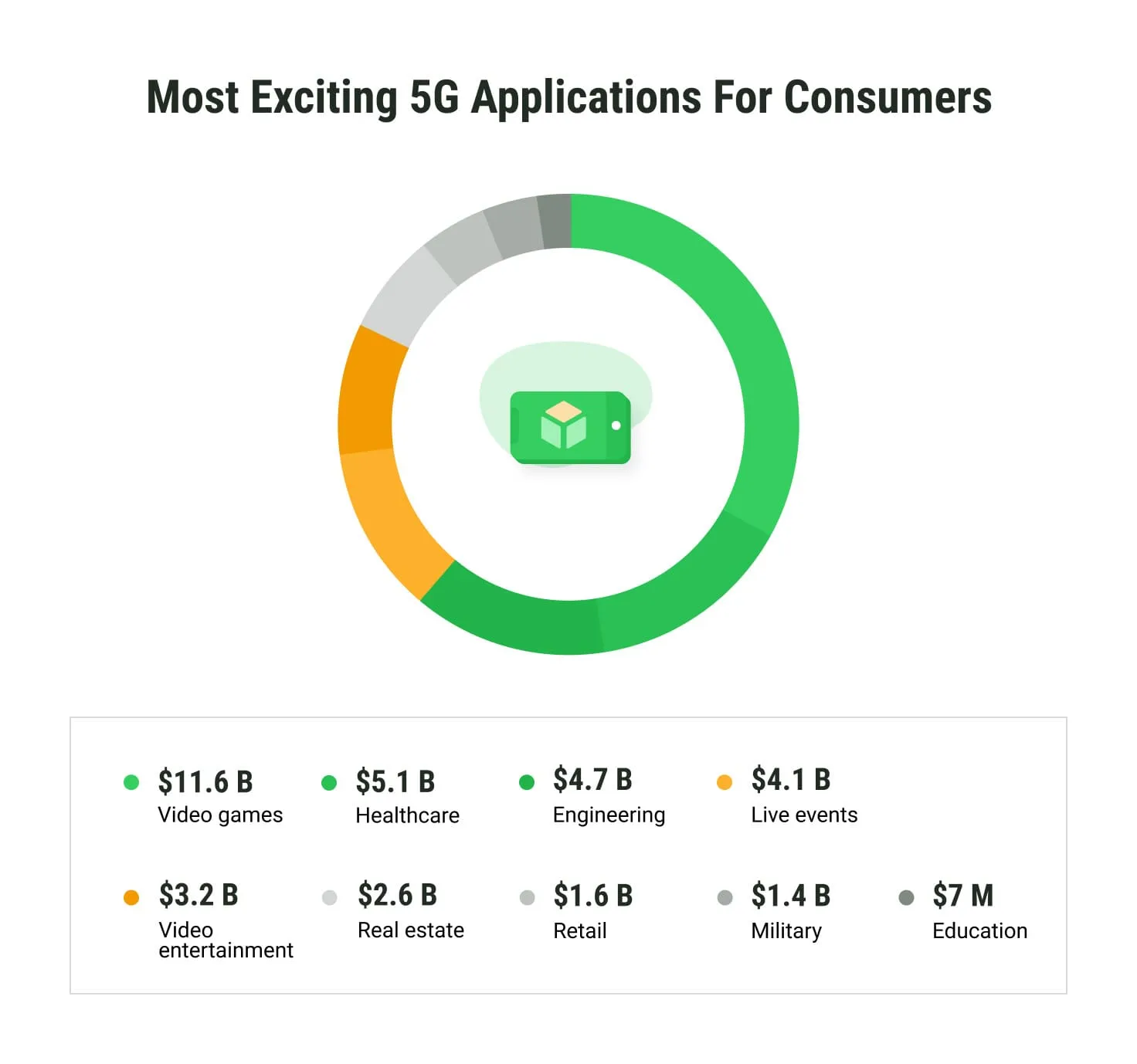3 Biggest Mobile App Trends of 2025 With Real-Life Use Cases
Table of contents
To be successful, businesses must always keep their finger on the pulse of the latest shifts in the market and stay updated with industry trends. And because we live in a world moving in a mobile direction, every business, regardless of the industry, needs to be aware of the latest mobile app development trends. This is especially important for companies with a mobile presence.
With so many channels of information at your fingertips, it can be difficult to determine what trends are legitimate and which are just fads or fake news. That’s why we narrowed down this year's top mobile technology waves. And here’s what you need to know.
State of the Mobile App Market in 2025
Coming closer and closer to the end of 2024, we can see which mobile app technology trends have shaped the current situation on the market with over 4.8 million mobile apps available in all app stores: 2.87 million on the Play Store and almost 2 million on the App Store. It is worth saying that according to Grand View Research, the global revenue for these mobile apps has significantly increased in recent years: in 2019, the market’s worth was $154 billion, and it reached $318 billion in 2020. Experts from the same agency state that by 2025, this number is expected to practically double to $613 billion.
What’s more, it is around 1.8 times higher than on Google Play Store. And when it comes to the latter, it takes the position of the market leader in user downloads.
To get a deeper understanding of the current situation, let’s look at the data provided by the analytics platform Adjust, which shows what happened in the mobile market arena in the context of different sectors.
E-commerce and shopping
- 55% installs increase and 21% sessions increase in MENA YoY
- 25% median day 1 retention rate for marketplace apps
- $14 ARPMAU in LATAM, the highest globally
Gaming
- 83% YoY increase in installs for strategy games
- 30.75 average gaming app session length in minutes, globally
- 1.82 sessions per user per day for hyper casual and hybrid casual games
Finance
- 45% YoY boost in crypto app sessions
- $4.1 finance app ARPMAU in 2024
- 4.9 to 5.8 partners per app from 2023 to 2024
Major Technologies Impacting Mobile App Market in 2025
5G network technology
Perhaps you've already heard about 5G — a technology that is supposed to change how information is shared between devices, enhancing user experience and opening up space for a variety of advancements in mobile apps. Here's some data that can give you a taste of the upcoming technology impacts.

Characterized by low latency and much higher speed and bandwidth, 5G is expected to increase mobile apps' performance by affecting apps' components. For example, more complex elements can now consume more data, and the technologies below will confidently pave their way to mobile apps:
- Advanced AI, AR/VR/MR
- 4K streaming
- 360 video
- Cloud computing
- High-definition graphics
- Interconnected IoT devices
Thanks to 5G, human-to-machine and machine-to-machine interactions are just around the corner. App developers can make them come true in the coming years without incurring extra storage or processor demands. And here are some examples of what users expect most from the apps in the 5G era.

5G technology, a new buzzword in the mobile app development community, is a challenge and precious opportunity for tech specialists to use the maximum of their creative potential. Nevertheless, there are also a few things a mobile app development company should bear in mind when creating solutions for 5G networks.
- Firstly, enhanced connectivity brings inspiring opportunities together with security challenges.
- Secondly, 5G won't be available to everyone immediately, as the coverage of 5G towers now is not complete, and it’ll take time to cover all regions. So many users will use devices operating in 4G standard or lower for years after. So supporting these standards is essential to ensure a satisfying user experience.
While the first challenge can be addressed with security services, the second one is mainly out of control. But there are some compelling examples of how companies managed to find ways to facilitate the provision of access to their services. The same approach can be applied to 5G. One of them is the gaming streaming service Twitch which gave its users credentials of companies to whom they can send requests. But while it worked for Twitch, having over 140 million users worldwide, smaller companies have to put thought into developing other strategies. One of them is to offer users a free trial period for apps created for 5G so that users can test them to find out if it works well for the standard used on their device.
Augmented reality
AR in mobile apps is not something new. Nearly everyone has at least heard about it, and many tried. To be exact, statistics on the use of AR show that:
- Over 1 billion people worldwide use AR.
- AR awareness is more than 75% among people aged 16 to 44.
- Around half of Americans have been using AR without knowing about it.
However, the popularity of immersive realities has been increasing. Furthermore, if we take a step back to the previous technology discussed, 5G, we can assume that AR, MR, and VR will continue to expand. Even today, a forecast published on Markets and Markets shows that the market value of AR reached $15.3 billion in 2021 and is predicted to reach $73 billion by 2024. And Grand View Research states that AR revenue is expected to go up to $340 billion by 2028.
It's worth mentioning that such growth is supported by giants such as Apple, Google, and Facebook, who promote the technology by using it as a means to bolster their commercial efforts. And back to statistics, nearly 97% of Forbes' Most Valuable Brands utilize AR/VR.
Considering the fact that companies using augmented reality report 40% greater conversion, we can anticipate seeing AR as one of the most prominent mobile app technology trends for years to come. And let’s conclude this part by stating that while the gaming, engineering, and healthcare sectors have benefitted most from the use of the technology, it has the potential to bring a lot of good to other industries.
At Emerline, we’ve already delivered two of our own products with AR for the education and entertainment sectors: the GoDog app that helps dog owners to keep their pets well-behaved, fit, and happy and Smart 3D Colorbook with 3D pixel figures to color. One more use case of AR in a mobile app was the development of a music teaching app for kids that placed AR objects over video recordings when a child mastered a lesson. The same app also took advantage of AI — the next technology to discuss — to determine if a child follows the instructions provided by the app correctly (uses the right notes at the right time).
Artificial intelligence and machine learning
The last technology we're going to discuss has also been around for a while. Still, its constant development and incessant demand make it top the list of the hottest mobile trends. According to Statista, the worldwide market worth of Artificial Intelligence will cross $89 billion by 2025. What's more, Servion Global Solutions state that by the same year, AI will power 95% of all customer interactions, including live telephone and online conversations that will leave customers unable to ‘’spot the bot’’. To better understand the value and development of AI and ML in terms of the mobile experience, just take a look at some (by no means all) AI features modern iPhones have.

This year (and for sure beyond), AI and ML have created a groundwork for sophisticated innovations that go way beyond well-known voice assistants and chatbots. And here are some examples of how they are applied to mobile apps:
- AI has become an essential part of apps that recognize speech with natural language processing (NLP) and discourse acknowledgment — features we've already discussed in iPhones.
- Technologies are widely used for security purposes. Analyzing user behaviors and identifying them, they detect fraud, hacking events, and suspicious activities.
- AI opens up space for highly personalized e-commerce services by studying users' preferences and customer intent.
- AI-powered solutions can be used to help companies cope with their ecological footprint. For example, Google managed to reduce its energy consumption by 40% after applying ML solutions to its data center cooling systems.
- AI and ML are starting to play a pivotal role in healthcare, where they are used for automation and diagnosing and treating.
When it comes to healthcare, we have a unique case to share. Our team was involved in the development of a mobile application that allows recording surgeries, impersonalizing records by blurring sensitive data such as faces of patients and doctors, splitting the recorded videos, and then automatically uploading them to the cloud. The solution uses sound recognition techniques to create a surgery events log by recognizing speech and machine sounds. All these became possible with the use of machine learning, computer vision, and sound recognition our engineers applied to the project.
The Bottom Line
While all of these trends may sound familiar to you, knowing about how they evolve and the new opportunities they open is significant. Running a business requires knowing what’s happening in the mobile world because that’s where your current and prospective customers live.
So we hope this article helps you understand the current state of the mobile market better and decide if your existing mobile apps or those you plan to develop need any adjustments. Don’t hesitate to contact us with your ideas and questions. We would love to help contribute to the development of innovative solutions that make a difference.
Updated on Feb 28, 2025





